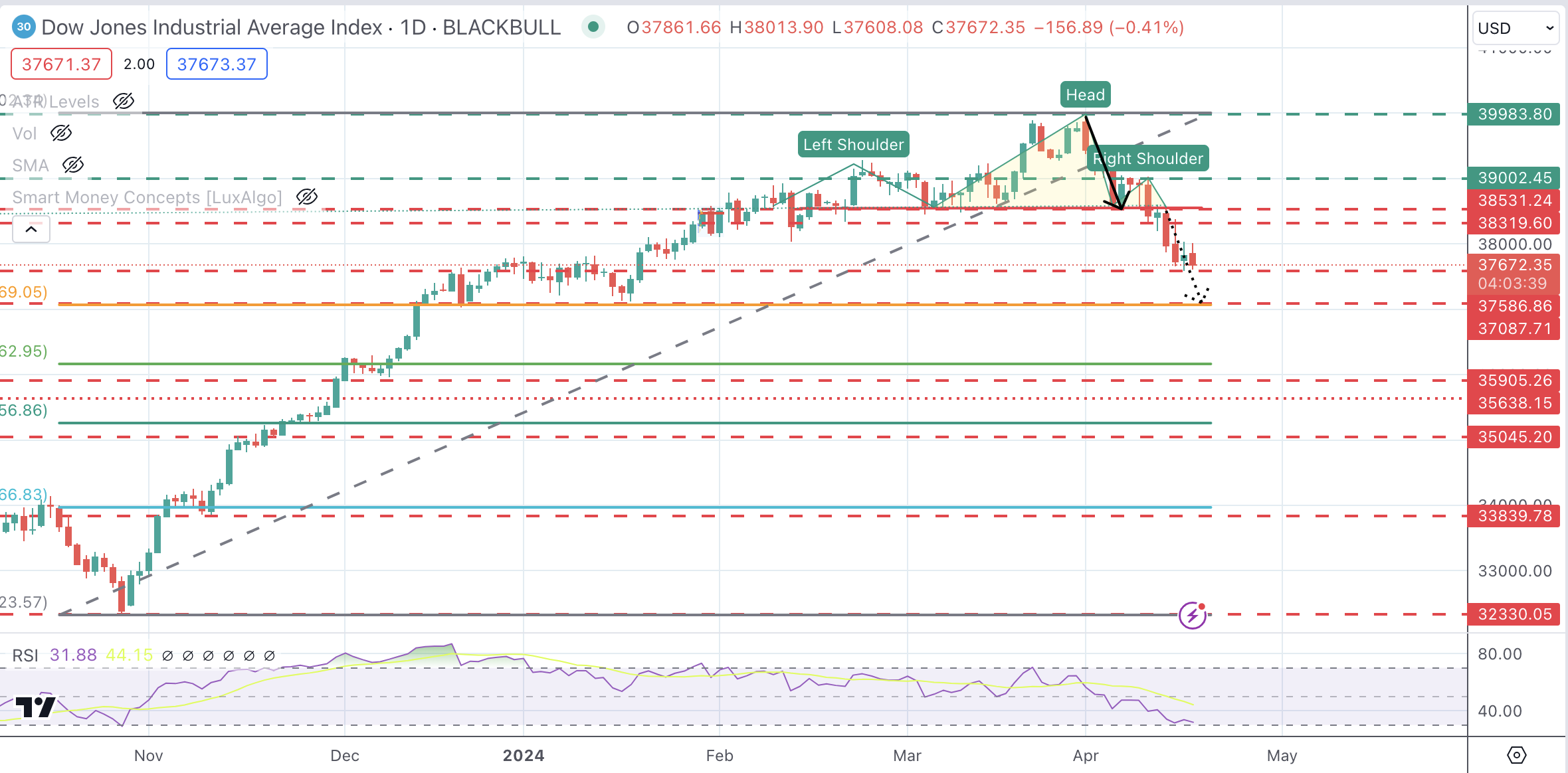Dow Jones wavers around session opening levels after bouncing from lows
- Dow Jones index has bounced up from lows, returning to the session opening level on afternoon trading.
- Market concerns about the Fed’s “higher for longer” stance keep weighing on risk appetite.
- Technical picture remains bearish with DJIA retreating from historic highs reached in March.
The Dow Jones Industrial Average (DJIA) has been trading back and forth around the opening level on Wednesday. Market sentiment remains frail following hawkish comments by Federal Reserve (Fed) Chair Jerome Powell on Tuesday and a string of downbeat quarterly earrings have soured market sentiment.
Powell observed the lack of progress on inflation on Tuesday and resumed the “higher for longer” monetary policy outlook, which is acting to dampen investors’ appetite for risk.
Quarterly earnings data disappointed on Wednesday with Travelers Companies (TRV) reporting profits below estimates, while US Bancorp’s (USB) net interest income fell by 14% in Q1. On the other hand, news that Microsoft is avoiding a formal EU probe over a $13 billion Open AI deal has soothed investors’ sentiment.
The main Wall Street indices are still in the red but coming up from session lows. The NASDAQ is leading losses with a 0.63% decline to 15,769, followed by the S&P 500, down 0.32% to 5,035, while the Dow Jones, trades flat, at 37,790.
Dow Jones news
The Technology sector is the worst performer on Wednesday, dropping 1.1%, weighed down by the outlook of high rates for a longer time. Industrials are following on Wednesday with a 0.61% decline. On the positive side, Utilities are up 1.76%, while Financials appreciate 0.34%.
Travelers Companies (TRV) plunges 7.61% to $206.25 following downbeat quarterly earnings. Intel (INTC) is next with a 1.6% drop to $35.67. United Health is the best performer, with a 3.1% rally to $483.78, followed by Goldman Sachs (GS) with a 1.92% gain to $404.5.
Dow Jones technical outlook
The DJIA index has reversed earlier gains and maintains an overall bearish picture intact. The move below 38,560 has activated a Head & Shoulders pattern that points toward a sharper decline.
Immediate support is 37,586, followed by the measured target of the H&S pattern, which meets the mid-January low and 38.6% Fibonacci retracement at 37,087. A bullish reaction might find resistance at the 38,531 previous support ahead of the 39,000 region (order block).
Dow Jones Index Daily Chart

Dow Jones FAQs
The Dow Jones Industrial Average, one of the oldest stock market indices in the world, is compiled of the 30 most traded stocks in the US. The index is price-weighted rather than weighted by capitalization. It is calculated by summing the prices of the constituent stocks and dividing them by a factor, currently 0.152. The index was founded by Charles Dow, who also founded the Wall Street Journal. In later years it has been criticized for not being broadly representative enough because it only tracks 30 conglomerates, unlike broader indices such as the S&P 500.
Many different factors drive the Dow Jones Industrial Average (DJIA). The aggregate performance of the component companies revealed in quarterly company earnings reports is the main one. US and global macroeconomic data also contributes as it impacts on investor sentiment. The level of interest rates, set by the Federal Reserve (Fed), also influences the DJIA as it affects the cost of credit, on which many corporations are heavily reliant. Therefore, inflation can be a major driver as well as other metrics which impact the Fed decisions.
Dow Theory is a method for identifying the primary trend of the stock market developed by Charles Dow. A key step is to compare the direction of the Dow Jones Industrial Average (DJIA) and the Dow Jones Transportation Average (DJTA) and only follow trends where both are moving in the same direction. Volume is a confirmatory criteria. The theory uses elements of peak and trough analysis. Dow’s theory posits three trend phases: accumulation, when smart money starts buying or selling; public participation, when the wider public joins in; and distribution, when the smart money exits.
There are a number of ways to trade the DJIA. One is to use ETFs which allow investors to trade the DJIA as a single security, rather than having to buy shares in all 30 constituent companies. A leading example is the SPDR Dow Jones Industrial Average ETF (DIA). DJIA futures contracts enable traders to speculate on the future value of the index and Options provide the right, but not the obligation, to buy or sell the index at a predetermined price in the future. Mutual funds enable investors to buy a share of a diversified portfolio of DJIA stocks thus providing exposure to the overall index.

